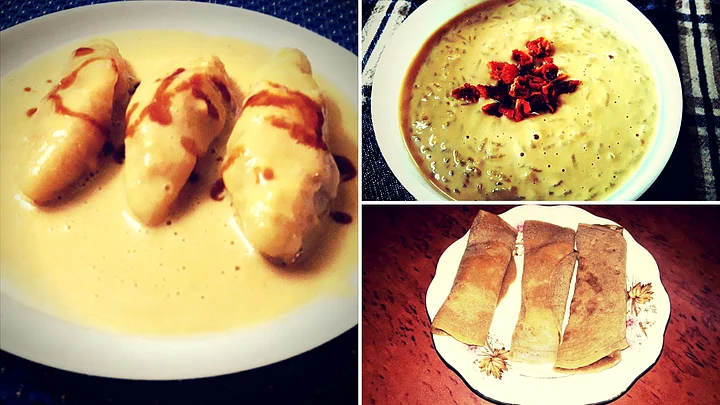As the north wind ushers in winter and the nip in the air is a welcome respite from the otherwise year-round muggy weather Bengal is infamous for, it's once again nolen gur season. Nolen gur or date palm jaggery is made from the sap of the date palm tree.
The process is only conducive during winter – which is also why new jaggery is available for the brief cold season. The liquid form or jhola gur is sampled, spread over rotis for breakfast, and the solidified patali gur is a substitute for sugar in many sweets and traditional Bengali homemade desserts.
While professional sweet makers hustle to make a quick buck as demand spikes for the brownish-pink chhana (cottage cheese) and nolen gur sandesh, and the famous jalbhara/talsas sandesh made from chhana and filled with amber-coloured nolen gur syrup that trickles out as you bite into it – back home, grandmothers get busy in their courtyards. They deftly scrape fresh coconut shavings to prepare an assortment of traditional homemade desserts filled with pithey – like Patishapta, Gokul pithy, Dudh puli pithe or Payesh.
Although advanced preservation techniques have added to its shelf-life and readymade Patishapta and Dudh puli pithey are available in the market, homemakers who've prepared these desserts for decades insist that only the new, intensely aromatic nolen gur satiates the Bengali’s saccharine taste-buds. When prepared at home, the smells of freshly grated coconut and warm milk stirred in heavy-bottomed vessels cause our homes to become redolent with the aroma of nolen gur.
And like with most traditional recipes, there are secrets too.
For instance, the rice flour obtained after soaking basmati rice for an hour, then leaving it to dry before it is ground in a mixer-grinder, make the best Patishapta pancakes.
For soft pulis, use semolina; grated coconut can be substituted with Makha sandesh made from chhana and nolen gur.
Pithey is the base for many traditional desserts and are specially prepared during Makar/Poush Sankranti.
Patishapta
Ingredients:
For Pancakes:
Rice flour: 1 cup
All purpose flour: 1/3 cups
Semolina: 1/3 tbsp
Nolen gur: 25 gms
Milk: 1 cup or as required
Water: 1 cup or as required
For Filling:
Fresh grated coconut: 1 ½ cup
Khoya: ½ cup
Nolen gur: 100 gms
Ghee: 1 tbsp (can be substituted with vegetable oil)
Method:
To prepare the filling in a pan, add the freshly grated coconut and cook on low flame till moisture evaporates. Add nolen gur; when jaggery dissolves, add khoya and cook until mixture leaves the sides. Allow to cool.
In another pan, add ½ cup of water and the jaggery. Cook on low to medium heat until jaggery dissolves and becomes a syrup. Turn off flame and allow to cool. In a mixing bowl, sieve the all purpose flour, add rice flour and semolina and the cooled syrup, mixing into a thick batter. Add milk to get a batter that is slightly thinner than the consistence of a dosa batter. Grease a non-stick pan, ladle in the batter enough to make a pancake.
Gently spread batter and cook on low flame until blisters appear. Now, spoon onto one corner of the filling, roll and cook a couple of minutes flipping over until a nice brown tinge appears.
Dudh Puli Pithey
Ingredients:
Milk: 1 ½ litre
Nolen gur: ½ cup
For Puli:
Rice flour: 1 cup
1 tbsp all purpose flour (Rice and all purpose flour can b substituted with 1½ cup semolina)
Warm water for kneading
The same filling as in Patishapta.
Method:
Take rice flour and all purpose flour in a large mixing bowl, add hot water, stir continuously and knead before mixture cools and dries. If using semolina, heat 1 cup water in a pan; once the water begins to boil, add the semolina, a pinch of salt, and cook until batter becomes a soft dough. Allow to cool.
Take small portions of dough, press into circles smaller than a regular puri, place a spoonful of filling and mould into half-moon shapes. Pinch edges together and roll in palms to obtain the spindle shape.
In a heavy bottom vessel, boil milk on medium flame until it is reduced to half. Add the pulis and cook for around ten minutes on medium flame – or until they begin to float. Turn flame off, then add jaggery. Once the jaggery melts, cook again for a few minutes.
Payesh
Ingredients:
Basmati or Govindbhogh rice: ½ cup soaked for an hour
Milk: 1 litre
Nolen gur: 100 gms, or as per your taste
Raisins: 10-12
Method:
In a large vessel, put milk to boil. Stir continuously until it reduces to about half, add the rice and cook it till almost done. Turn flame off and add jaggery. When jaggery melts, return to flame and cook for a couple of minutes more – or until rice is fully done. Garnish with raisins or dry fruit of your choice. Serve cold.
(Lesley D Biswas is a freelance writer who writes articles on parenting, environment, travel and women, besides fiction.)
(At The Quint, we question everything. Play an active role in shaping our journalism by becoming a member today.)
